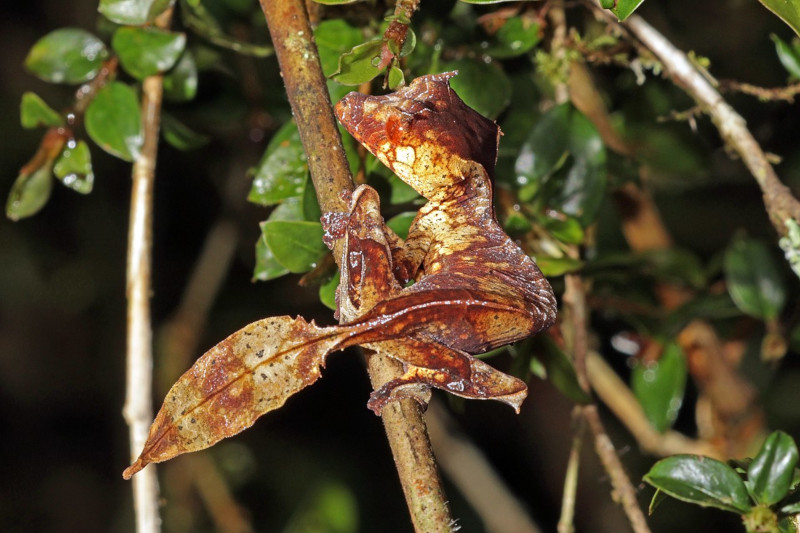
Satanic Leaf-Tailed Gecko Facts
- Quite amazingly, the distinctive term of the Satanic Leaf-Tailed Gecko serves as one of the common names for a truly unique reptile. Understandably, its truly attention-grabbing name directly derives from its remarkable appearance.
- This incredible living marvel of the resourcefulness of Nature, however, also goes by several other terms. These other terms include such highly unusual names as the eyelash leaf-tailed gecko and the phantastic leaf-tailed gecko.
- Its scientific name, meanwhile, remains that of the comparatively difficult to pronounce Uroplatus phantasticus. But, regardless of what name one chooses to use to refer to it, this unique creature truly stands out from related species.
- The respected Belgian naturalist, George Albert Boulenger became the first person to officially recognize it as a separate species. This recognition occurred in 1888. In addition to its appearance, it’s also one of the smallest members of its genus.
- Fortunately, although its range isn’t large, its population appears to be significant, and stable. This apparently holds true throughout the entirety of it. The IUCN, therefore, currently lists the incredible Satanic Leaf-Tailed Gecko as Least Concern.
- This fortunate status presently appears on the organization’s Red List of Threatened Species. Nevertheless, the magnificent reptile does face some potential threats to its existence. In this, at least, it remains like a great many other species around the world.
- Firstly, the simple fact that it has a highly limited range makes it especially vulnerable to such factors as habitat loss. Secondly, however, its greatest threat most likely comes from the devastating ongoing effects of climate change.
Related Articles
Satanic Leaf-Tailed Gecko Physical Description
The amazing Satanic Leaf-Tailed Gecko does deserve appreciation, to be certain. This evaluation does not, however, occur due to its sheer physical size. That holds true due to the simple fact that this particular species remains a very small form of reptile.
In point of fact, even among other geckos, it ranks as quite diminutive. Truly amazingly, this species attains a size of less than half the average overall length of a gecko. Firstly, an approximately average length for a gecko measures roughly 7 – 8 in (17.8 – 20.3 cm).
Secondly, although by no means the smallest of its kind, this species only grows to about 3.5 in (9 cm) in overall length. Thirdly, this lizard does display a slight degree of the trait of sexual dimorphism. In its case, though, this has nothing to do with size.
Like many geckos, of course, the stunning Satanic Leaf-Tailed Gecko appears in a quite wide range of colors. More specifically, this great range of colors most commonly includes several shades of brown, with small black dots on the underside.
This reptile nevertheless also develops various patterns of differing hues of orange, tan, yellow, and even purple. The gender-based difference, however, has nothing to do with its patterns of color. This actually appears in regards to the tail of the animal.
That’s the case since this develops highly flattened in nature, like a leaf, thus, the common name. But, this tail also has multiple notches in it, further emulating a leaf. The gender differences present themselves in the fact that males display more notches than females.
- Kingdom: Animalia
- Phylum: Chordata
- Class: Reptilia
- Order: Squamata
- Family: Gekkonidae
- Genus: Uroplastus
- Species: U. phantasticus
Satanic Leaf-Tailed Gecko Distribution, Habitat, and Ecology
The remarkably mesmerizing Satanic Leaf-Tailed Gecko evolved as endemic to an area of the world already renowned for its incredible flora and fauna. Quite unfortunately, however, that same region also represents one of its great limiting factors.
In fact, this area constitutes an extremely small and isolated region of the globe. More specifically, this holds true due to the fact that this true marvel of Nature evolved as native solely to the astounding island of Madagascar, near Africa.
Incredibly, even there the animal only inhabits a very specific portion of the island. In point of fact, it only appears in the southern two-thirds of the eastern section of the island. In addition, this region consists almost exclusively of mountainous rainforests.
Nature apparently took all of these factors into consideration, though. The very nature of its environment serves as the reason for the bizarre evolution of its unique tail. This appendage further assists the awesome lizard in blending in with fallen foliage.
The extremely fascinating Satanic Leaf-Tailed Gecko further spends the great majority of its time practicing patience. This time it spends waiting near the base of the trunks of various trees. But it sometimes climbs them as well, up to a height of about 6 ft (1.83 m).
Here, the natural camouflage evolution devised for it allows the small carnivore to feed on a variety of prey. As a result, its diet consists of a relatively wide variety of local insects. Meanwhile, it in turn mainly falls prey to snakes and birds of prey.
Species Sharing Its Range
Check out our other articles on Earth’s Many Magnificent Bees, Armored Sea Robin, Blyde River Canyon, Wax Currant, Long-Finned Pilot Whale, Saint Francis’ Satyr Butterfly, Gila Monster
